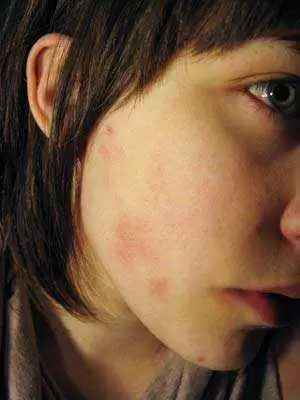
Celiac.com 08/17/2018 - Mucosal dryness is among the top non-gastrointestinal complaints of patients with gluten intolerance and celiac disease.
Prolonged eye dryness, itching and chronic inflammation of the eye lids (blepharitis), mouth dryness, excessive thirst, frequent yeast infections, skin dryness and vaginal dryness in women may represent clinical symptoms of Sjogren’s syndrome. Named after Swedish ophthalmologist Henrik Sjögren, Sjogren’s syndrome is one the most common (and one of the most commonly underdiagnosed) rheumatic/autoimmune diseases. The disease most frequently affects women (10 women for every man) and usually appears in women around and after menopause. However, the disease can affect either gender at any age.
Celiac.com Sponsor (A12):
In addition to mucosal and skin dryness, Sjogren’s syndrome can cause joint pain and stiffness, damage to peripheral nerves leading to numbness and tingling of fingers and toes, fatigue, brain fog, inflammation of blood vessels, hair loss, poor food digestion due to pancreatic damage and various problems with the cardiac muscle and its conduction system causing arrythmia and myocarditis. Patients suffering from Sjogren’s syndrome quite frequently deal with recurring yeast infections, chronic periodontal disease, recurring canker sores and poor dental health.
The diagnosis of Sjogren’s syndrome is based on:
- Demonstration of mucosal dryness upon physical examination
- Specific blood tests (positive anti-SSA/Ro and anti-SSB/La antibodies, elevated levels of serum immunoglobulin G)
- Ultrasound imaging of salivary glands
On rare occasions, a diagnosis of Sjogren’s syndrome requires confirmation through a small salivary gland biopsy or special nuclear medicine studies.
It is well documented that patients with gluten intolerance and celiac disease have an increased risk of Sjogren’s syndrome. Similarly, patients with Sjogren’s syndrome are characterized by the increased prevalence of gluten intolerance and celiac disease.
The connection between Sjogren’s syndrome and gluten intolerance is not a coincidental one: there are well-studied molecular mechanisms explaining this link. In the late 1980s/early 1990s genetic studies in Sjogren’s patients demonstrated an increased presence of the class II major histocompatibility complex protein HLA DQ2. Furthermore, HLA DQ2 positivity was found to be associated with increased titers of Sjogren’s specific anti-SSA/Ro and anti-SSB/La antibodies. The link between gluten and Sjogren’s syndrome became obvious in the mid to late 1990s when it was discovered that HLA-DQ2 binds to deamidated gluten peptides and presents them to mucosal CD4+ T cells thus initiating a chain of events eventually leading to autoimmune responses.
The second set of data came from the discovery of BM180 protein. This protein regulates tear secretion in the lacrimal acinar cells. Suprisingly, amino acid sequence of BM180 has a similarity with alpha-gliadin and, therefore, can attract inflammatory cells activated by gluten thus contributing to the development of eye dryness.
The actual prevalence of gluten intolerance in Sjogren’s patients based on published data varies from 20% to 40% depending on the criteria used to define gluten intolerance. The data from our clinic (Institute for Specialized Medicine) indicate that gluten intolerance can affect almost half of patients with Sjogren’s syndrome. Additionally, our data show that one third of patients with gluten intolerance have evidence of mucosal dryness and Sjogren’s syndrome.
The frequency of documented celiac disease in patients with Sjogren’s syndrome is in the vicinity of 5%.
The following is a patient case history from our clinic:
- A 28 year old woman was seen in our clinic due to her complaints of long-standing irritable bowel syndrome and recent onset of eye dryness. Her initial presentation included abdominal pain, bloating and irregular bowel movements. She was seen by several gastroenterologists and underwent several upper endoscopies and colonoscopies with mucosal biopsies which were non-diagnostic. Her lab test results showed positive IgG anti-gliadin antibodies and she was told that “this is a common finding among healthy people, and is not indicative of any illnesses.” She was seen by her ophthalmologist and prescribed with contact lenses which she could not wear due to significant eye discomfort and irritation. Further eye examination showed that she had diminished tear production and was referred to our clinic to rule out Sjogren’s syndrome.
Upon physical examination in our clinic the patient not only demonstrated profound eye dryness but also showed evidence of dry mouth, fissured tongue and patchy areas of thrush as well as very dry skin. A sonographic evaluation of her major salivary glands was suspicious for moderately advanced Sjogren’s syndrome. Her laboratory test results showed: positive anti-SSA/Ro antibodies, elevated serum immunoglobulin G, low neutrophil count as well as low levels of vitamin D and ferritin (a serum marker of iron storage state). Also, the patient was found to have positive serum IgG and salivary IgA anti-gliadin antibodies as well as positive HLA DQ2 (a molecular marker associated with gluten intolerance).
Based on a combination of clinical history, physical findings and laboratory test results, the patient was diagnosed with gluten intolerance and Sjogren’s syndrome. In addition to the aforementioned tests, the patient underwent food intolerance testing based on serum IgG4 antibodies which showed not only gluten but also cow’s casein intolerance. Her treatment options included a traditional route of therapy based on drugs or an integrative approach based on dietary modifications and food supplements. She opted for the integrative approach and started a gluten-free and dairy-free diet as well as iron glycinate, vitamin D, specific probiotics and digestive enzymes.
After the first month on the diet and supplements, she reported a remarkable improvement of her irritable bowel symptoms and in three months, she started noticing an improvement of the dryness. Laboratory tests performed six months after initiation of the therapy showed normalization of the IgG level, disappearance of anti-SSA/Ro antibodies and a slightly suppressed neutrophil count. Through following the prescribed diet and supplements she is now symptom free.
Why do we need to treat Sjogren’s syndrome? Left untreated, Sjogren’s syndrome can cause debilitating dryness affecting gastrointestinal and respiratory tracts. Clinically, this manifests as difficulty in swallowing solid foods, heartburn, malabsorption of nutrients and minerals, bloating, weight loss, chronic sinus infections and prolonged dry cough. Sjogren’s syndrome also significantly increases the risk for malignancies affecting lymphatic nodules, known as lymphomas.
Therapy for Sjogren’s syndrome is based on the treatment of mucosal dryness and the autoimmune component of the disease. In addition, patients affected by Sjogren’s syndrome need to have regular screenings for malignancies (specifically lymphomas) and premalignant conditions.
Traditional therapy for Sjogren’s syndrome (treatment of dryness):
- Cyclosporin (brand name Restasis) eye drops and artificial tears for dry eyes.
- Numoisyn lozenges and liquid, as well as Caphosol for mouth dryness and mucositis.
- Cevimeline (brand name Evoxac) and pilocarpine (brand name Salagen) for systemic dryness therapy.
Treatment of autoimmune disturbances:
- Hydroxychloroquin (brand name Plaquenil).
- Leflunomide (brand name Arava).
- Severe autoimmune conditions associated with Sjogren’s syndrome are treated with the biologic drug rituximab (brand name Rituxan).
- Integrative therapy for Sjogren’s syndrome.
- Ear acupuncture (auricular therapy) and body acupuncture to stimulate tear and saliva production.
- Elimination diet based on individual food-intolerance profiles.
- Oral probiotics (for example, BLIS K12) and intestinal probiotics.
- Digestive enzymes.
- Fish and krill oils.
- Black currant seed oil.
- Cordyceps sinensis in combination with wormwood extract to treat the autoimmune component of Sjogren’s syndrome.
- Zinc and elderberry lozenges.
- N-acetyl-L-cysteine and glutathione.
Our extensive clinical experience demonstrate that early cases of Sjogren’s syndrome can be completely reversed (by both clinical and laboratory criteria) by the strict gluten-free and elimination diet. The advanced cases cannot be reversed; however, even in advanced cases the gluten-free and elimination diet can slow the progression of the disease.
If you’re concerned that dryness may represent Sjogren’s syndrome, see a rheumatologist for further evaluation and management of your condition.
References:
- Alvarez-Celorio MD, Angeles-Angeles A, Kraus A. Primary Sjögren’s Syndrome and Celiac Disease: Causal Association or Serendipity? J Clin Rheumatol. 2000 Aug;6(4):194-7.
- Asrani AC, Lumsden AJ, Kumar R, Laurie GW. Gene cloning of BM180, a lacrimal gland enriched basement membrane protein with a role in stimulated secretion. Adv Exp Med Biol. 1998;438:49-54.
- Feuerstein J. Reversal of premature ovarian failure in a patient with Sjögren syndrome using an elimination diet protocol. J Altern Complement Med. 2010 Jul;16(7):807-9.
- Iltanen S, Collin P, Korpela M, Holm K, Partanen J, Polvi A, Mäki M. Celiac disease and markers of celiac disease latency in patients with primary Sjögren’s syndrome. Am J Gastroenterol. 1999 Apr;94(4):1042-6.
- Lemon S, Imbesi S., Shikhman A.R. Salivary gland imaging in Sjogren’s syndrome. Future Rheumatology, 2007 2(1):83-92.
- Roblin X, Helluwaert F, Bonaz B. Celiac disease must be evaluated in patients with Sjögren syndrome. Arch Intern Med. 2004 Nov 22;164(21):2387.
- Teppo AM, Maury CP. Antibodies to gliadin, gluten and reticulin glycoprotein in rheumatic diseases: elevated levels in Sjögren’s syndrome. Clin Exp Immunol. 1984 Jul;57(1):73-8.








.thumb.jpeg.68baa0c544d6e8650c8d7d90634190c3.jpeg)



Recommended Comments
There are no comments to display.
Create an account or sign in to comment
You need to be a member in order to leave a comment
Create an account
Sign up for a new account in our community. It's easy!
Register a new accountSign in
Already have an account? Sign in here.
Sign In Now